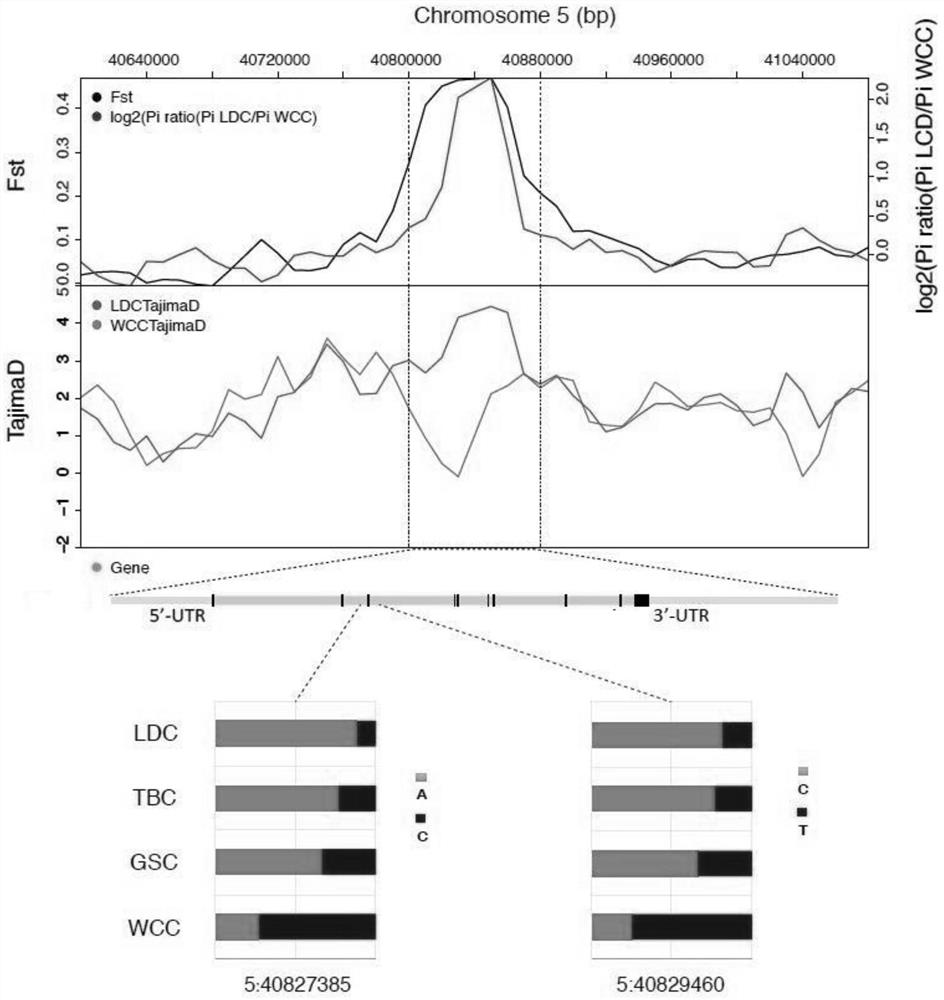Molecular marker related to chicken heat stress tolerance, primer combination and detection and identification method thereof
A molecular marker and chicken heat stress technology, which is applied in the fields of genetic engineering and genetic breeding, can solve the problem that the molecular markers of chicken heat stress tolerance are still few and other problems, and achieve the effect of simple operation and low cost.
- Summary
- Abstract
- Description
- Claims
- Application Information
AI Technical Summary
Problems solved by technology
Method used
Image
Examples
Embodiment 1
[0027] Four local breed chickens grown in different environments in China were selected, including 50 Wenchang chickens, Dongxiang green-shelled chickens, Tibetan chickens and Lindian chickens. 2 mL blood samples were collected from the fin vein in EDTA-Na anticoagulation tubes, and the phenol-chloroform method was used. Genomic DNA extraction was performed. Whole genome sequencing was performed on the Illumina Hiseq PE150 platform after DNA quality control. By omitting linker sequences (>10nt for calibration with adapters, allowing ≤10% mismatches), remove low-quality sequences including ≥10% unrecognized nucleotides or >50% with base sequencing quality <5 , to remove PCR repeats that may be generated during library construction. Using the BWA (Burrows-Wheeler Aligner) (version 0.7.8) software package, the remaining high-quality paired sequences were matched with the chicken reference genome Gallus_gallus-5.0 with the command mem-t4-k32 M; at the same time, in order to reduc...
Embodiment 2
[0030] In order to further investigate whether the allelic mutation frequency pattern of the above two SNP loci is related to the adaptation to high temperature environment, four other local chicken breeds in China, including Minqing Maojiao chicken (MQMC) and Guangxi Longshengfeng chicken (LSFC), were selected in the experiment. ), Shandong Jining Bairi Chicken (JNC) and Beijing Oil Chicken (BJYC), 100 each, as well as 191 Brazilian local chickens (Brazilian), 1439 Ghana local chickens (Ghana) and 1399 Tanzania local chickens (Tanzania). 2 mL blood samples were collected intravenously in EDTA-Na anticoagulant tubes, and genomic DNA was extracted by phenol-chloroform method. After passing the DNA quality control, the target fragments of the two SNP sites related to high temperature tolerance were amplified. The upstream and downstream primers for the amplification of the two sequences were as follows:
[0031] Primer with base at position 40827385 of chromosome 5:
[0032] Up...
Embodiment 3
[0052] In order to further explore whether the allele mutation frequencies of the above two SNP loci are suitable for the identification of heat stress tolerance populations, 180 35-week-old layer A and 180 layer B were selected in the experiment. Feed a basal ration, ad libitum. In this experiment, a cyclic heat stress test was performed, and the temperature was set as: 20:00-00:00, 00:00-06:00 was set to 28°C, 06:00-10:00, 16:00-20:00 was set to 32°C, 10:00-16:00 set to 35°C. The trial period was 2 weeks. On the 14th day of the test, the production performance was counted, and the blood was collected to extract DNA, and then amplified according to the two pairs of primer sequences and PCR conditions in Example 2, and then sent to the company for sanger sequencing to detect the genes of the two SNP sites in Example 2. type.
[0053] The results are shown in Table 3. The rectal temperature, respiratory rate, egg production rate and mortality rate of chickens in group B were...
PUM
 Login to View More
Login to View More Abstract
Description
Claims
Application Information
 Login to View More
Login to View More - R&D
- Intellectual Property
- Life Sciences
- Materials
- Tech Scout
- Unparalleled Data Quality
- Higher Quality Content
- 60% Fewer Hallucinations
Browse by: Latest US Patents, China's latest patents, Technical Efficacy Thesaurus, Application Domain, Technology Topic, Popular Technical Reports.
© 2025 PatSnap. All rights reserved.Legal|Privacy policy|Modern Slavery Act Transparency Statement|Sitemap|About US| Contact US: help@patsnap.com



